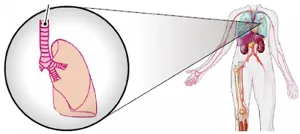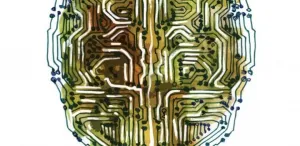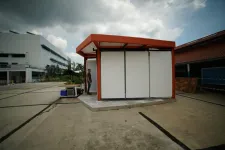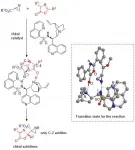(Press-News.org) Durham, NC - A phase 2 clinical trial whose results were released today in STEM CELLS Translational Medicine might point to a way to overcome bronchopulmonary dysplasia (BPD), a major cause of death in preterm infants. The study, conducted by researchers at Samsung Medical Center, Sungkyunkwan University and Asan Medical Center Children's Hospital in Seoul, evaluates the effectiveness of treating these infants by transplanting umbilical cord blood-derived mesenchymal stem cells (UCB-MSCs) directly into their tracheas.
Early results showed signs of improvement for the most immature infants included in the trial.
BPD is a serious breathing disorder in which the lungs do not develop normally. Most infants who develop BPD are born more than 10 weeks before their due date, weigh less than 2 pounds at birth, and have breathing problems. Infections that occur before or shortly after birth also can contribute to the disorder. Despite recent advances in neonatal medicine, BPD remains a major cause of mortality and long-term respiratory and neurologic problems in premature infants.
Won Soon Park, M.D., Ph.D., of Samsung Medical Center and Sungkyunkwan University School of Medicine, and Ellen Ai-Rhan Kim, M.D., Ph.D., of Asan Medical Center Children's Hospital, University of Ulsan, are both pediatricians who have been searching for a way to treat BPD. As such, the two were co-authors of the recent study, which was a double-blind randomized, placebo-controlled phase II clinical trial designed specifically to learn whether human UCB-derived MSC intratracheal transplantation might mitigate BPD in extremely preterm infants.
"While intratracheal transplantation of human UCB-derived MSCs has proven to be safe and feasible in recently conducted clinical trials, its therapeutic efficacy had not been assessed in a clinical setting prior to this study," Dr. Park said.
Choosing the optimal MSCs for transplantation was also a critical point of their work, added Dr. Kim. "We focused on UCB-MSCs, as they exhibit several advantages over adult tissue-derived MSCs, including lower immunogenicity, higher proliferation capacity, paracrine potency and therapeutic efficacy both in vitro and in vivo," she said. "Moreover, allogenic transplantation of MSCs, which come from a donor rather than the patient, might have a logistic advantage as they can be used at an early active stage of disease."
Sixty-six preterm infants ranging in age from 23 to 28 gestational weeks (GW) were included in the study. All were on ventilators and each also had experienced significant respiratory difficulties between five and 14 days after birth. The infants were grouped by age - either 23-24 GW or 25-28 GW - and then further randomly divided into groups that received either UCB-MSCs or a placebo. The infants were then assessed for six months.
In their final analysis, the team verified that intratracheal transplantation of MSCs appears to be safe and feasible.
"At the same time, we learned that MSC transplantation did not significantly improve the primary outcome of death or severe/moderate BPD in infants in the 25-28 GW group. However, our subgroup analysis showed that the secondary outcome of severe BPD was significantly improved - dropping from 53 percent to 19 percent - in the younger 23-24 GW group," Dr. Park said.
Dr. Kim added, "Further study with a larger sample size is required to solidly prove therapeutic benefits for infants in this group who are at the highest risk for BPD or death. Accordingly, we are now conducting an additional larger and controlled phase II clinical trial focusing on 23-24 GW infants. We hope to publish these data in the near future."
"This study suggests that the transplantation of umbilical cord blood-derived mesenchymal stem cells directly into the tracheas of preterm babies might mitigate their breathing challenges," said Anthony Atala, M.D., Editor-in-Chief of STEM CELLS Translational Medicine and Director of the Wake Forest Institute for Regenerative Medicine. "The data are encouraging and useful and should lead to a larger, future clinical trial."
INFORMATION:
The full article, "Stem cells for bronchopulmonary dysplasia in preterm infants: A randomized controlled phase II trial," can be accessed at https://stemcellsjournals.onlinelibrary.wiley.com/doi/abs/10.1002/sctm.20-0330.
About STEM CELLS Translational Medicine: STEM CELLS Translational Medicine (SCTM), co-published by AlphaMed Press and Wiley, is a monthly peer-reviewed publication dedicated to significantly advancing the clinical utilization of stem cell molecular and cellular biology. By bridging stem cell research and clinical trials, SCTM will help move applications of these critical investigations closer to accepted best practices. SCTM is the official journal partner of Regenerative Medicine Foundation.
About AlphaMed Press: Established in 1983, AlphaMed Press with offices in Durham, NC, San Francisco, CA, and Belfast, Northern Ireland, publishes two other internationally renowned peer-reviewed journals: STEM CELLS®, celebrating its 39th year, is the world's first journal devoted to this fast paced field of research. The Oncologist®, also a monthly peer-reviewed publication, entering its 26th year, is devoted to community and hospital-based oncologists and physicians entrusted with cancer patient care. All three journals are premier periodicals with globally recognized editorial boards dedicated to advancing knowledge and education in their focused disciplines.
About Wiley: Wiley, a global company, helps people and organizations develop the skills and knowledge they need to succeed. Our online scientific, technical, medical and scholarly journals, combined with our digital learning, assessment and certification solutions, help universities, learned societies, businesses, governments and individuals increase the academic and professional impact of their work. For more than 200 years, we have delivered consistent performance to our stakeholders. The company's website can be accessed at http://www.wiley.com.
About Regenerative Medicine Foundation (RMF): The non-profit Regenerative Medicine Foundation fosters strategic collaborations to accelerate the development of regenerative medicine to improve health and deliver cures. RMF pursues its mission by producing its flagship World Stem Cell Summit, honouring leaders through the Stem Cell and Regenerative Medicine Action Awards, and promoting educational initiatives.
Embargoed press materials are now available for the virtual Experimental Biology (EB) 2021 meeting, featuring cutting-edge multidisciplinary research from across the life sciences. EB 2021, to be held April 27-30, is the annual meeting of five scientific societies bringing together thousands of scientists and 25 guest societies in one interdisciplinary community.
Complete a Press Registration Form for complimentary meeting registration and full access to our virtual newsroom. We encourage advance registration as it may take up to a day to receive access.
Join Our Virtual Press Conference
Reporters are invited to join a live Q&A discussion of selected research announcements during a virtual EB press conference held ...
Eyes play an important role in social communication by expressing the intentions of our interlocutors, and even more so in times of pandemic when half of the face is hidden. But is this eye contact automatic and rapid? Is it based on a priority attentional reaction or, on the contrary, on a particular emotional reaction? To answer these questions, researchers at the University of Geneva (UNIGE), Switzerland, looked at the way we process human gaze, focusing on the estimation of the temporal duration of social interactions. They discovered that when we make eye contact with another person, our attention is directly solicited, causing a distortion in our temporal perception. As a result, time seems shorter than it really is. ...
A biomimicking "spiking" neural network on a microchip has enabled KAUST researchers to lay the foundation for developing more efficient hardware-based artificial intelligence computing systems.
Artificial intelligence technology is developing rapidly, with an explosion of new applications across advanced automation, data mining and interpretation, healthcare and marketing, to name a few. Such systems are based on a mathematical artificial neural network (ANN) composed of layers of decision-making nodes. Labeled data is first fed into the system to "train" the model to respond a certain way, then ...
LA JOLLA, CALIF. - April 20, 2021 Scientists at Sanford Burnham Prebys have identified, at an atomic level, how a part of a protein called PLEKHA7 interacts with a cell's membrane to regulate important intercellular communications. The research, published in the journal Structure, points to hotspots within PLEKHA7 as targets for drugs. These targets could be key in designing treatments for advanced colon, breast and ovarian cancers.
The region, or domain, in PLEKHA7 that the researchers examined, pleckstrin homology (PH), is commonly found in proteins ...
A long-awaited, high-tech analysis of the upper body of famed fossil "Little Foot" opens a window to a pivotal period when human ancestors diverged from apes, new USC research shows.
Little Foot's shoulder assembly proved key to interpreting an early branch of the human evolutionary tree. Scientists at the END ...
Recent growth in the number of healthcare workers providing home care for Medicare patients is "small and inadequate" compared with the increasing demand in an aging America, a new study suggests.
To have hope of keeping up, Medicare likely will need to reconsider how it compensates providers for home care, the researchers say.
"Only 0.7 percent of physicians in Medicare provided home care regularly," said Nengliang "Aaron" Yao, PhD, a researcher with the University of Virginia School of Medicine's Section of Geriatric Medicine. "Targeted policies are needed to support home-based medical care."
Trends in Home Care
Growth in the field of home care was "modest but steady" between 2012 and 2016, with most of the growth coming from increasing numbers of nurse practitioners providing home ...
A novel system of chilled panels that can replace air conditioning can also help reduce the risk of indoor disease transmission, suggests new analysis from the University of British Columbia, University of Pennsylvania and Princeton University.
The researchers computed air conditioning requirements in 60 of the world's most populous cities--with the additional ventilation required due to COVID-19. Then, they compared the energy costs with their cooling method, using the chilled panels and natural ventilation.
The results, published in the COVID-19 edition of Applied Energy, showed that the alternative solution can save up to 45 per cent of the required energy, while ensuring building occupants are comfortable ...
Nearly three-quarters of Earth's land had been transformed by humans by 10,000BC, but new research shows it largely wasn't at the expense of the natural world.
A study involving University of Queensland researchers combined global maps of population and land use over the past 12,000 years with current biodiversity data, demonstrating the effective environmental stewardship of Indigenous and traditional peoples.
UQ's Professor James Watson said the findings challenged the modern assumption that human 'development' inevitably led to environmental destruction.
"There's a paradigm among natural scientists, conservationists and policymakers that ...
Unless you've studied chemistry in college, it's unlikely you've come across the name aziridine. An organic compound with the molecular formula, C2H4NH, aziridines are well-known among medicinal chemists, who make use of the compound to prepare pharmaceutical drugs such as Mitomycin C, a chemotherapeutic agent known for its anti-tumor activity. Specifically, aziridines are what chemists call "enantiomers"--molecules that are mirror images of each other and cannot be superposed on one another. A peculiarity with enantiomers is that the biological activity ...
A team headed by Dr. Phillip M. Maffettone (currently at National Synchrotron Light Source II in Upton, USA) and Professor Andrew Cooper from the Department of Chemistry and Materials Innovation Factory at the University of Liverpool joined forces with the Bochum-based group headed by Lars Banko and Professor Alfred Ludwig from the Chair of Materials Discovery and Interfaces and Yury Lysogorskiy from the Interdisciplinary Centre for Advanced Materials Simulation. The international team published their report in the journal Nature Computational Science from 19 April 2021.
Previously manual, time-consuming, error-prone
Efficient analysis of X-ray diffraction data (XRD) plays a crucial role in the discovery of new materials, for example for the energy ...






